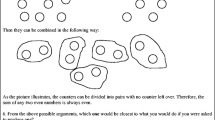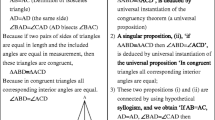Abstract
Undergraduate students are expected to produce and comprehend constructive existence proofs; yet, these proofs are notoriously difficult for students. This study investigates students’ thinking about these proofs by asking students to validate two arguments for the existence of a mathematical object. The first argument featured a common structural error while the second was a valid argument of the claim. We found that the students often considered the logical structures of the arguments when validating them. They provided reasons for their evaluations, including why they thought the structure of the first argument functioned to prove the claim and why they thought the structure of the second argument did not function to prove the claim. We discuss how these reasons provide insights into why constructive existence proofs might be challenging for students. We end the paper with implications for the teaching and learning of constructive existence proofs and their proof frameworks.





Similar content being viewed by others
Notes
If the reader interpreted the implicit warrants in the proof to be bi-directional, then they would feel confident that the solved for object would have to be a solution.
This count includes PUG-4 who offered a reason why the Valid Argument was not a proof, but did not ultimately commit to her decision.
References
Abbott, S. (2015). Understanding analysis. Springer.
Bartlo, J. R. (2013). Why ask why: an exploration of the role of proof in the mathematics classroom (Doctoral dissertation, Portland State University).
Braun, V., & Clarke, V. (2006). Using thematic analysis in psychology. Qualitative Research in Psychology, 3(2), 77–101.
Brown, S. A. (2017). Who’s there? A study of students’ reasoning about a proof of existence. International Journal of Research in Undergraduate Mathematics Education, 3(3), 466–495.
De Guzmán, M., Hodgson, B. R., Robert, A., & Villani, V. (1998). Difficulties in the passage from secondary to tertiary education. In Proceedings of the international Congress of Mathematicians (vol. 3, pp. 747–762). Berlin, Germany: Documenta Mathematica.
Fukawa-Connelly, T. P. (2012). A case study of one instructor’s lecture-based teaching of proof in abstract algebra: Making sense of her pedagogical moves. Educational Studies in Mathematics, 81(3), 325–345.
Halliday, M., & Matthiessen, C. M. (2013). Halliday’s introduction to functional grammar. Routledge.
Harel, G., & Sowder, L. (1998). Students’ proof schemes: Results from exploratory studies. American Mathematical Society, 7, 234–283.
Inglis, M., & Alcock, L. (2012). Expert and novice approaches to reading mathematical proofs. Journal for Research in Mathematics Education, 43(4), 358–390.
Kontorovich, I., & Zazkis, R. (2017). Mathematical conventions: Revisiting arbitrary and necessary. For the Learning of Mathematics, 37(1), 29–34.
Lakatos, I. (1978). Mathematics, science and epistemology: Volume 2, Philosophical Papers (Vol. 2). Cambridge University Press.
Larsen, S., Strand, S., & Vroom, K. (2022). How undergraduate students think about summation (sigma) notation. Manuscript submitted for publication.
Leron, U. (1985). A direct approach to indirect proofs. Educational Studies in Mathematics, 16(3), 321–325.
Lew, K., & Mejía-Ramos, J. P. (2019). Linguistic conventions of mathematical proof writing at the undergraduate level: Mathematicians’ and Students’ Perspectives. Journal for Research in Mathematics Education, 50(2), 121–155.
Lockwood, E., Caughman, J. S., & Weber, K. (2020). An essay on proof, conviction, and explanation: Multiple representation systems in combinatorics. Educational Studies in Mathematics, 103(2), 173–189.
McKee, K., Savic, M., Selden, J., & Selden, A. (2010). Making actions in the proving process explicit, visible, and “reflectable”. In Proceedings of the 13th Annual Conference on Research in Undergraduate Mathematics Education.
Mejía-Ramos, J. P., Fuller, E., Weber, K., Rhoads, K., & Samkoff, A. (2012). An assessment model for proof comprehension in undergraduate mathematics. Educational Studies in Mathematics, 79(1), 3–18.
Melhuish, K., Vroom, K., Lew, K., & Ellis, B. (2021). Operationalizing authentic and disciplinary activity for the undergraduate context. In D. Olanoff, K. Johnson, & S. M. Spitzer (Eds.), Proceedings of the forty-third annual meeting of the North-American chapter of the international group for the psychology of mathematics education (pp. 349–385). Philadelphia, Pennsylvania.
Moore, R. C. (1994). Making the transition to formal proof. Educational Studies in Mathematics, 27(3), 249–266.
Rasmussen, C., Zandieh, M., & Wawro, M. (2009). How do you know which way the arrows go? The emergence and brokering of a classroom mathematics practice. In W. M. Roth (Ed.), Mathematical Representation at the Interface of Body and Culture (pp. 171–218). Information Age Publishing.
Samper, C., Perry, P., Camargo, L., Sáenz-Ludlow, A., & Molina, Ó. (2016). A dilemma that underlies an existence proof in geometry. Educational Studies in Mathematics, 93(1), 35–50.
Schaub, B. (2021). Creating community: a case study of students’ experiences in inquiry-based learning. Oregon State University.
Selden, J., & Selden, A. (1995). Unpacking the logic of mathematical statements. Educational Studies in Mathematics, 29(2), 123–151.
Selden, A., & Selden, J. (2003). Validations of proofs considered as texts: Can undergraduates tell whether an argument proves a theorem? Journal for Research in Mathematics Education, 34(1), 4–36.
Selden, J., & Selden, A. (2010). Teaching proving by coordinating aspects of proofs with students’ abilities. In D. A. Stylianou, M. L. Blanton, & E. J. Knuth (Eds.), Teaching and learning proof across the grades: A K-16 perspective (pp. 339–354). D.A. Routledge/Taylor & Francis.
Selden, A., & Selden, J. (2013). Proof and problem solving at university level. The Mathematics Enthusiast, 10(1), 303–334.
Selden, A., & Selden, J. (2017). A comparison of proof comprehension, proof construction, proof validation and proof evaluation. In R. Göller, R. Biehler, R. Hochmuth, & H. Rück (Eds.), Proceedings of the Conference on Didactics of Mathematics in Higher Education as a Scientific Discipline (pp. 339–345).
Selden, A., Selden, J., & Benkhalti, A. (2018). Proof frameworks: a way to get started. Primus, 28(1), 31–45.
Stylianides, A. L. (2007). Proof and proving in school mathematics. Journal for Research in Mathematics Education, 38(3), 289–321.
Vroom, K. (2020). Guided reinvention as a context for investigating students’ thinking about mathematical language and for supporting students in gaining fluency. Doctoral dissertation, Portland State University.
Vroom, K. (2022). A functional perspective on student thinking about the grammar of multiply quantified statements. Manuscript submitted for publication.
Weber, K. (2009). Mathematics majors’ evaluation of mathematical arguments and their conception of proof. In Proceedings of the 12th Conference for Research in Undergraduate Mathematics Education.
Weber, K. (2010). Mathematics majors’ perceptions of conviction, validity, and proof. Mathematical Thinking and Learning, 12(4), 306–336.
Weber, K. (2015). Effective Proof Reading Strategies for Comprehending Mathematical Proofs. International Journal of Research in Undergraduate Mathematics Education, 1(3), 289–314. https://doi.org/10.1007/s40753-015-0011-0
Acknowledgements
We would like to thank Dr. Sean Larsen for his feedback and the anonymous reviewers for their support in refining this work.
Funding
This work is part of the Advancing Students' Proof Practices in Mathematics through Inquiry, Reinvention, and Engagement project (NSF DUE #1916490). The opinions expressed do not necessarily reflect the views of the NSF.
Author information
Authors and Affiliations
Corresponding author
Ethics declarations
Ethics Approval
The authors report the study was approved by an Internal Review Board.
Consent to Participate
The authors report that all participants gave informed consent.
Consent for Publication
All authors give consent for the publication of this manuscript.
Conflicts of Interest
We report that there is no conflict of interest.
Additional information
Publisher's Note
Springer Nature remains neutral with regard to jurisdictional claims in published maps and institutional affiliations.
Rights and permissions
About this article
Cite this article
Vroom, K., Alzaga Elizondo, T. Students’ Thinking about the Structure of Constructive Existence Proofs. Int. J. Res. Undergrad. Math. Ed. (2022). https://doi.org/10.1007/s40753-022-00170-3
Accepted:
Published:
DOI: https://doi.org/10.1007/s40753-022-00170-3




